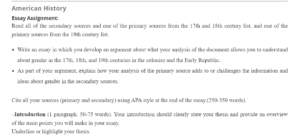Gender in the 17th-19th centuries
During the 17th and 18th centuries, laws determined women’s status in society. There were specific rules that outlined women’s practices and expectations. Besides, these laws also conditioned women’s dependency. As a result, early America dominated society where men controlled almost everything from national politics to domestic property (Snyder, 2015). By the end of the 19th century, women had redefined their position in society and started advocating for more rights. Women were oppressed in the 17th and 18th century where they were prohibited from important activities such as voting and owning property.
As opposed to the current times where women can participate in all ‘men’s activities’, things were different in the previous three centuries. These centuries can be termed as centuries of oppression for women and the century that experienced many social movements advocating for women’s rights. The gender roles in the 19th century limited women from carrying out important activities. They had made women domestic slaves, and most of their activities revolved around there. They also defined how women were supposed to behave-women were expected to be submissive, pure, domestic, and pious and pass these qualities to their women. In a nutshell, women were supposed to give birth, look after their children and pass desirable attributes.
As much as women’s oppression was ongoing in the 17th and 18th centuries, African American women suffered more. This was because they faced racial discrimination from their fellow white women and were often isolated in women’s justice fights. For instance, in southern states, white women sought free labor from black women, who used this opportunity to redefine their public and private lives. They were employed to do house chores such as washing dishes and cooking.
In conclusion, gender norms in the 17th, 18th, and 19th centuries mostly oppressed women, who were confined to domestic duties. They were supposed to submit to the men and pass on good qualities to their children. However, the Civil War that emerged in America opened a new chapter in American women’s lives where they realized they could control areas that men, such as the labor market earlier, dominated.
References
Snyder, T. (2015). Women Race and the Law in Early America. doi:10.1093/acrefore/9780199329175.013.12
Reconstruction and Women. The American YAWP
ORDER A PLAGIARISM-FREE PAPER HERE
We’ll write everything from scratch
Question
American History
Essay Assignment:
Read all of the secondary sources and one of the primary sources from the 17th and 18th century list, and one of the primary sources from the 19th century list.

Gender in the 17th-19th centuries
- Write an essay in which you develop an argument about what your analysis of the document allows you to understand about gender in the 17th, 18th, and 19th centuries in the colonies and the Early Republic.
- As part of your argument, explain how your analysis of the primary source adds to or challenges the information and ideas about gender in the secondary sources.
Cite all your sources (primary and secondary) using APA style at the end of the essay.(250-350 words).
–Introduction (1 paragraph. 50-75 words). Your introduction should clearly state your thesis and provide an overview of the main points you will make in your essay.
Underline or highlight your thesis.
–Body. (3-4 paragraphs. 200-250 words [total]). The main body of your essay should include the evidence and analysis that supports your thesis. Each paragraph should develop one main point and open with a topic sentence that clearly states that main point. Provide specific evidence from the primary source you selected and explain how the evidence supports your thesis. Also incorporate evidence from the secondary sources, explaining how it supports or challenges your thesis; if you are arguing the secondary source challenges your thesis, make a case for your interpretation.
–Conclusion (1 paragraph. 50-75 words). Provide an overview of the main points you have made and identify briefly larger questions your analysis might raise or another context in which the issues could be examined.
Secondary Sources:
- Servitude_in_New_England
- Women,_Race,_and_the_Law_in_Early_America___Oxford_Research_Encyclopedia_of_American_History
- HarrietJacobsTheSlavesNewYearsDay
Primary Sources:
- 8._The_Market_Revolution___THE_AMERICAN_YAWP
- 10._Religion_and_Reform___THE_AMERICAN_YAWP
- 15._Reconstruction___THE_AMERICAN_YAWP (1)

